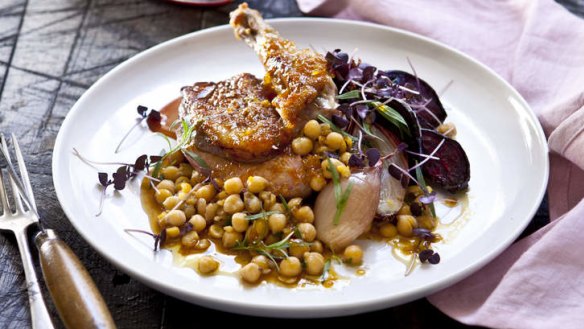A drizzle of saucy citrus magic
Karen Martini's restaurant-style main course, roasted duck breast with a chickpea salad. Pre-make the syrup and it can be on the table in under an hour.

The bitter-sweet marmalade tang of this syrup adds a great accent to creamy desserts and elevates a scoop of vanilla ice-cream into something special. With a careful hand, it also adds complexity to dressings or sauces for savoury dishes.
Scorched lemon syrup
This sauce requires careful judgment with the caramel, as you need some darker tones and a faint tinge of bitterness. If it burns, you'll have to start over.
250g castor sugar
5 lemons, zested and juiced (about 350ml)
1. Add sugar to a dry pot (about 22cm size) over high heat, shake the pan so the sugar liquefies and colours evenly - don't stir.
2. Continue to cook the sugar, shaking the pan when necessary, for about 8 minutes. You want the sugar to turn to a dark-coloured caramel without burning, which will give the sauce a light bitterness. Be careful, as it is extremely hot.
3. Remove from the heat and add the lemon juice and zest - step back as it will spit. Stir and return to the heat, bring to a simmer until the caramel is fully amalgamated with the juice.
4. Take off the heat, pour into a clean jar and refrigerate until cold and syrupy.
Makes about 500ml
Duck breast, beetroot and chickpea salad, scorched lemon vinaigrette
If you already have the scorched lemon syrup you can easily have this on the table in less than an hour.
1 cup chickpeas, soaked overnight
1 fresh bay leaf
8 eschalots, loose papery skin removed
80ml extra virgin olive oil, plus extra
2 beetroot, trimmed, washed and sliced in wedges (no need to peel)
Salt flakes
Freshly ground black pepper
4 large duck breasts, winglet attached, skin on and scored in a crisscross fashion
2½ tbsp scorched lemon syrup
60ml sherry vinegar
1 small clove garlic, grated on a Microplane
8 sprigs of tarragon, picked
1 punnet red garnet cress, or use other cress
1. Cook the chickpeas until tender in plenty of boiling water with the bay leaf - this will take about 50 minutes, but depends on the age of the chickpeas. While they cook prepare the other components.
2. Preheat the oven to 170 degrees fan-forced or 190 degrees conventional.
3. Oil the eschalots and roast in a pan for 30 minutes until soft.
4. Toss the beetroot with a dash of oil, season and roast in a pan for 25 minutes, flipping occasionally to colour evenly. Once cooked, remove, set aside. Turn the oven up to 200 degrees fan-forced or 220 conventional.
5. Season the skin of the duck well with salt. With a little oil, brown the duck breasts in a large frying pan skin-side down for about 5 minutes over medium heat, then flip and quickly seal the flesh.
6. Roast the duck breasts in the oven, skin-side up, for six minutes then rest - you may need to adjust the cooking time depending on the size of the duck portions.
7. Make the dressing by mixing the scorched lemon sauce, sherry vinegar, the 80ml of oil, garlic and some salt and pepper until well combined.
8. Cut the eschalots in half, leave skin on.
9. Drain the well-cooked chickpeas and squash half of them roughly.
Mix the whole chickpeas through the mashed ones with half the dressing and season to taste.
10. Pile some chickpeas on each plate with the beetroot and eschalots alongside.
Slice the rested duck breasts in half and lay over the top. Scatter over some snipped cress and tarragon, spoon over some more dressing and serve.
Serves 4
Drink Beaujolais
Vanilla and fig-leaf panna cotta with scorched lemon syrup
This may seem unusual, but fig leaves impart the same smoky notes that make figs distinctive. You could substitute a sprig of rosemary.
370ml milk
750ml cream
120g castor sugar
½⁄ vanilla bean
5 small fig leaves, freshly picked and washed
3½⁄ gold-strength leaf gelatine sheets (5.5g), soaked in very cold water for 5 or 10 minutes
lemon syrup
amaretti biscotti - bought is fine
1. In a medium pan, warm the milk, cream, sugar and vanilla bean (and scraped seeds). Roll the fig leaves to break the fibres and release flavour then add them to the pan. Bring to a simmer over a medium flame then take off the heat.
2. Drain off the gelatine and squeeze out any water. Drop into the pot, stir through and allow to sit for 15 minutes.
3. Strain the mix through a fine strainer and pour into 10 x 120ml-capacity dariole moulds to the top. Chill in the fridge overnight or for at least six hours.
4. To serve, tip the mould towards you and, with the tip of your finger, gently pull the top edge of the panna cotta away from the side to break the seal (don't use hot water to remove them). Rotate the mould gently, then turn out on a plate. Spoon over some cooled lemon syrup and serve with biscotti, whole or crushed and crumbled over the top.
Makes 10
Drink Botrytis semillon
The best recipes from Australia's leading chefs straight to your inbox.
Sign up